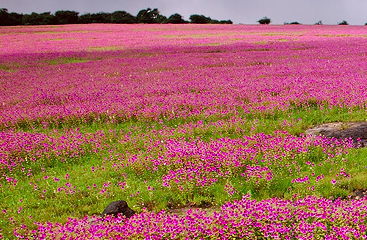Kaas Pather (Satara)
About Kaas Plateau:
The Kaas Plateau, also known as the Kaas Pathar or Kas Sadas, is a plateau situated 25 kilometres west from Satara city in Maharashtra, India. It falls under the Sahyadri Sub Cluster of the Western Ghats, and it became a part of a UNESCO World Natural Heritage Site in 2012. It is a biodiversity hotspot known for various types of seasonal wild flowers bloom and numerous species of endemic butterflies annually in the months of August,September,October.
The plateau is situated at an altitude of 1200 metres and is approximately 10 square kilometers in area. Kaas has more than 850 different species of flowering plants of which 624 are listed on the IUCN Red List. These include orchids, shrubs such as the Karvy, and carnivorous plants such as Drosera Indica. Kaas plateau is a plateau located near Satara. It is situated high hill plateaus and grasslands turns into a 'valley of flowers' during monsoon season, particularly from August to early October. Kaas Plateau has more than 150 or more types of flowers, shrubs and grasses. The orchids bloom here for a period of 3 - 4 weeks during this season. Kaas plateau is a World Natural Heritage site.
In September, some of the most common flowering plants are Eriocaulon manoharani, Pogostemon deccanensis, Senecio grahamii, Impatiens oppositifolia and Dipcadi montanum. The plateau experiences a natural cycle of extreme conditions, with wet water-logged cool monsoons, very dry barren hot summer (45°C) and dry winter (5°C). The soil is a thin layer on top of Deccan rock, with varying quality of nutrients. The annual cyclic ecosystem here, and nearby similar but smaller lateritic plateaus, has adapted to these conditions. The entire flowering plants and their related plants are typically restricted to that particular locality only. This is because the plateau is largely formed of basalt which is directly exposed to atmosphere. The basalt is covered almost entirely by a thin cover of soil formed due to erosion and has accumulated a layer of not more than a inch or so. This soil is neither black nor lateritic.
At certain places water gets accumulated because of uneven surface. Such places appear like small puddles which harbor a typical marshy flora. Because of this particular situation of soil the plants growing on Kaas plateau are typically of herbaceous nature of like grasses. Botanically the flora is labelled as “herbaceous”. The small shrubs and trees are located at the periphery of the plateau.
Major Attractions:
Kaas Pathar- Plateau of Flowers
Rich Bio-diversity of Kaas- Endangered / Rare / Endemic / Common Species
Plateau changes its colour after every 15- 20 days, as the cycle of flowering plants progresses with the monsoon from August to October.
Brief on the IUCN Red List at Kaas.
Ajinkyatara Fort
Local cuisines to keep us energetic throughout the event
